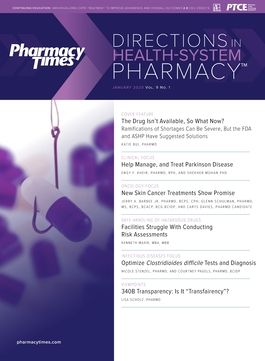Publication
Article
Pharmacy Practice in Focus: Health Systems
Help Manage and Treat Parkinson Disease
Author(s):
Pharmacists play an integral role and can improve patients’ quality of life with proper communication, counseling, and monitoring.
An estimated 10 million people worldwide live with Parkinson disease (PD).1 In the United States, about 60,000 each year receive a diagnosis, with 1 million Americans estimated to live with PD in 2020.1 PD itself is not fatal, but complications from the disease rank as the 14th-leading cause of death in the United States.1
Pathophysiology
PD is a debilitating, incurable brain disorder that results from the deterioration and death of neurons.2 These neurons, which are primarily responsible for the release of dopamine, are found in the substantia nigra within the brainstem. Dopamine facilitates the body’s balance and coordinated, smooth movement. Patients do not start to experience severe motor symptoms until about 80% of their neurons have died, making early diagnosis important for effective treatment. The reason these neurons start to progressively deteriorate and die remains unknown.
Categorizing Symptoms
Pharmacists should be aware of the clinical presentation of PD. Symptoms can be divided into 2 categories: motor and nonmotor.
Motor symptoms (Table) are known collectively by the acronym TRAP:
• Tremor
• Rigidity
• Akinesia/bradykinesia
• Postural instability
Nonmotor symptoms include anxiety, bent-over body, constipation, depression, drooling, incontinence, insomnia, masklike face, and muffled speech.
Treatment Considerations
Pharmacists are an essential resource in managing treatment options with PD patients. They are equipped with the proper knowledge and training to provide vital information, support, and care to patients with PD, whether in a community setting, a hospital, or another setting. Below are the most important nonpharmacological and pharmacological treatment options that should be considered for each patient, taking symptoms and severity of their condition into account.
Nonpharmacological: Lifestyle Factors2,3
To reduce constipation, a patient should avoid high-fat foods, eat meals high in fiber, and maintain adequate hydration. Counseling, support groups, and/or evaluation for mental health referrals can be key for dealing with the emotional aspects.
Physical exercise, such as swimming performed at a high intensity, helps maintain overall fitness.
Speech therapy can benefit patients whose symptoms affect their communication abilities.
Pharmacological: Motor Symptoms4
The choice of treatments for patients with PD depends on several factors, including the patient’s extent of disease, age, medication preferences, and symptom severity. The goal
of therapy is to delay disease progression, improve the quality of life, manage the severity of symptoms, and minimize complications.

The following medications are approved for symptom management of PD:
- Amantadine
- Carbidopa-levodopa (Sinemet)
- Catechol-O-methyltransferase inhibitors, such as entacapone (Comtan)
- Centrally acting anticholinergics, such as benztropine (Cogentin)
- Dopamine agonists, such as apomorphine, pramipexole (Mirapex), ropinirole (Requip)
- Selective monoamine oxidase MAO-B inhibitors, such as rasagiline (Azilect) and selegiline (Eldepryl, Zelapar)
- Safinamide (Xadago): approved for adjuvant use with carbadopa-levodopa in patients who experience an “off” episode
As PD progresses, medications will need adjustment; patients will begin to experience more adverse effects (AEs) as their drugs’ effects wear off more quickly. Pharmacists can help address difficult medication schedules. They can also help facilitate effective communication between the patient and provider in the pursuit of minimizing AEs.
Pharmacists’ Role5
Below are some steps pharmacists can take to help ensure optimal patient outcomes and safety:
- Advise patients to not crush any oral medications before checking with their primary care physician or pharmacist.
- Educate patients and family members on the importance of adherence and of not abruptly discontinuing any medications.
- Monitor for efficacy and safety of medications.
- Offer alternatives to patients who can no longer swallow oral medications.
- If the patient experiences any medication-related AEs that are intolerable, report these cases to the patient’s primary care physician.
- Review the patient’s profile to ensure that they are not taking any medications that can exacerbate PD symptoms, including haloperidol, metoclopramide, paliperidone, prochlorperazine, and risperidone.
- Watch for drug-drug interactions. No nonselective MAO inhibitor and decarboxylase inhibitor, such as Sinemet, should be given together, for instance; these classes together are contraindicated and require a 2-week separation period.
The Pharmacist’s Role
PD is a chronic movement disorder that progressively worsens. It has no cure, but available therapies can help alleviate and manage symptoms quite effectively. With adherence to the proper treatment, patients can live long, manageable lives. Pharmacists play a key role in helping patients manage PD and can improve these patients’ quality of life with proper communication, counseling, and monitoring.
REFERENCES
- Statistics. Parkinson’s Foundation website. parkinson.org/Understanding-Parkinsons/Causes-and-Statistics/Statistics. Accessed December 6, 2019.
- Patel T, Chang F; Parkinson Society Canada. Parkinson’s disease guidelines for pharmacists. Can Pharm J (Ott). 2014;147(3):161-170. doi: 10.1177/1715163514529740.
- Fleisher J, Tarsy D. Nonpharmacologic management of Parkinson disease. UpToDate website. uptodate.com/contents/nonpharmacologicmanagement-of-parkinson-disease. Updated November 18, 2019. Accessed December 6, 2019.
- Parkinson’s disease in adults. National Institute for Health and Care Excellence website. nice.org.uk/guidance/ng71. Published July 2017. Accessed December 6, 2019.
- Multiple Entries. Lexi-Drugs. Lexi-Comp Online. Lexi-Comp, Inc. Hudson, OH. online.lexi.com/crlonline. Accessed December 6, 2019.







